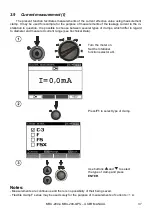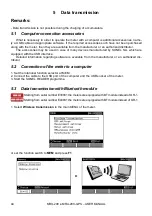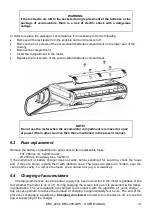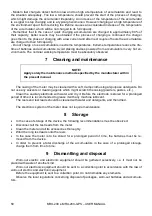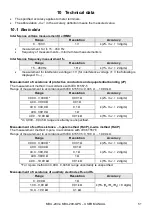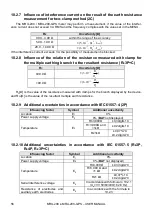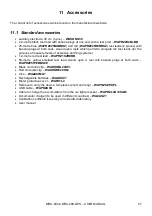
MRU-200
● MRU-200-GPS – USER MANUAL
50
- Modern fast chargers detect both too low and too high a temperature of accumulators and react to
the situation adequately. Too low a temperature should prevent the start of the process of charging,
which might damage the accumulator irreparably. An increase of the temperature of the accumulator
is a signal to stop charging and is a typical phenomenon. However charging at a high temperature of
the environment apart from reducing the lifetime causes an accelerated increase of the temperature
of the accumulator, which will be not charged to its full capacity.
- Remember that in the case of quick charging accumulators are charged to approximately 80% of
their capacity; better results may be obtained if the process of charging is continued: the charger
goes then to the phase of charging with a low current and after next couple of hours the accumulators
are charged to their full capacity.
- Do not charge or use accumulators in extreme temperatures. Extreme temperatures reduce the life-
time of batteries and accumulators. Avoid placing devices powered from accumulators in very hot en-
vironments. The nominal working temperature must be absolutely observed.
7
Cleaning and maintenance
NOTE!
Apply solely the maintenance methods specified by the manufacturer within
the present manual.
The casing of the meter may be cleaned with a soft, damp cloth using all-purpose detergents. Do
not use any solvents or cleaning agents which might scratch the casing (powders, pastes, etc.).
Clean the auxiliary electrode with water and dry it. Before the electrode is stored for a prolonged
period of time it is recommended to grease it with any machine lubricant.
The reels and test leads should be cleaned with water and detergents, and then dried.
The electronic system of the meter does not require maintenance.
8
Storage
In the case of storage of the device, the following recommendations must be observed:
Disconnect all the test leads from the meter.
Clean the meter and all its accessories thoroughly.
Wind the long test leads onto the reels.
In the case the meter is to be stored for a prolonged period of time, the batteries must be re-
moved from the device.
In order to prevent a total discharge of the accumulators in the case of a prolonged storage,
charge them from time to time.
9
Dismantling and disposal
Worn-out electric and electronic equipment should be gathered selectively, i.e. it must not be
placed with waste of another kind.
Worn-out electronic equipment should be sent to a collection point in accordance with the law of
worn-out electric and electronic equipment.
Before the equipment is sent to a collection point, do not dismantle any elements.
Observe the local regulations concerning disposal of packages, worn-out batteries and accumula-
tors.


